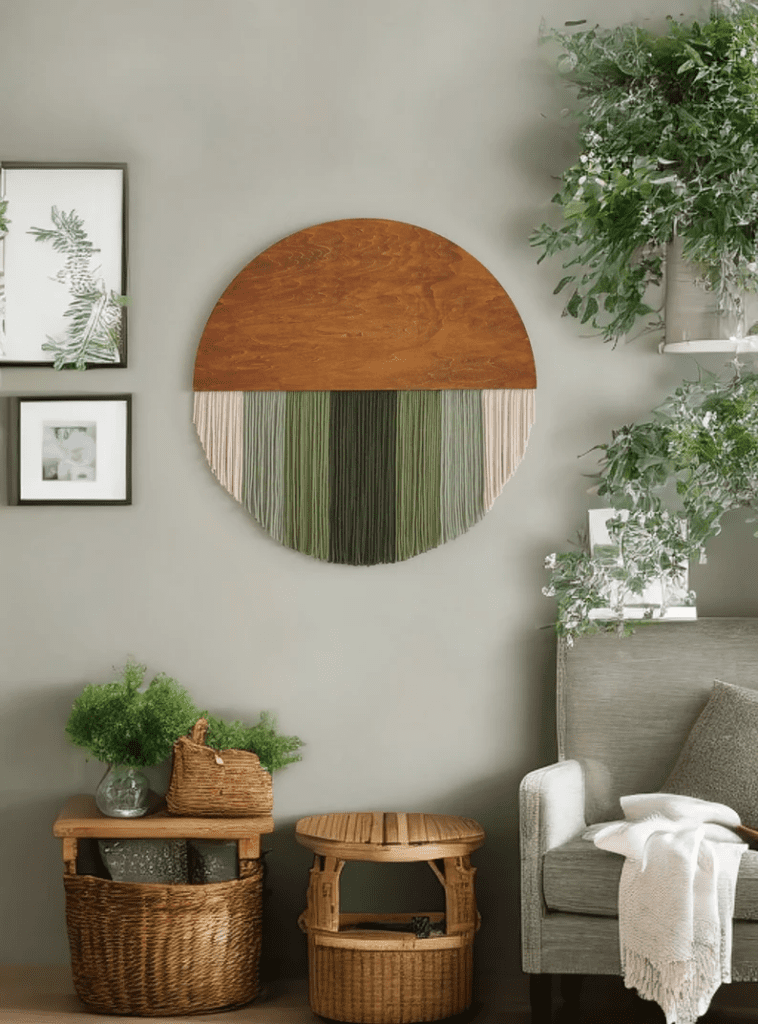This post contains affiliate links. As an Amazon associate I may earn small commission from qualifying products at no cost to you.
Minimalism is more than just a design choice—it’s a way of life. And if you’re someone who loves the simplicity of Japanese aesthetics but also craves the warmth of Scandinavian interiors, then Japandi interior design might just be your dream home style.
Think of Japandi as the lovechild of two iconic styles: the elegant restraint of Japanese interior design and the cozy functionality of Scandinavian minimalism. It’s a delicate balance between clean lines and inviting textures, between sleek simplicity and mindful warmth.
So, how can you bring Japandi style into your home? Whether you’re revamping an entire space or just looking for a few elegant tweaks, these 10 inspiring Japandi interior design ideas will help you create a home that feels effortlessly serene, stylish, and functional.
Table of Contents
1. What colors are used in Japandi style?
Japandi design isn’t about bold splashes of color—it’s all about subtle, earthy tones. Think soft beiges, gentle greys, warm taupes, and muted greens. These colors bring a sense of calmness to a space, echoing the natural world.
Pro Tip: Start with a neutral base and introduce deeper accent shades like charcoal, terracotta, or olive green through furniture or decor.
Example: A Japandi living room might have soft off-white walls, a taupe linen sofa, and a hint of warmth with a rust-colored throw pillow.
Why it Works: The muted colour palette makes your space feel more spacious and relaxed—without ever looking dull.

2. Japandi Style Furniture
Japandi style is all about beautiful, functional furniture. Think of low-profile, wooden furniture with sleek lines and minimal ornamentation. Every piece should serve a purpose and enhance the overall harmony of the room.
Pro Tip: When shopping for furniture, look for pieces that are both aesthetically pleasing and highly practical.
Example: A Japandi coffee table in natural wood with clean lines and hidden storage compartments keeps your space clutter-free while maintaining style.
Why it Works: The right furniture pieces create a balance between elegance and functionality—a key principle of Japanese minimalist interior design.

3. Embrace Natural Materials
One of the most defining features of Japandi decor is its love for organic materials. Wood, stone, bamboo, linen, and rattan bring warmth and depth to an otherwise minimalist space.
Pro Tip: Incorporate textural contrast—pair smooth ceramic vases with soft linen curtains or mix a rough stone bowl with a smooth oak table.
Example: A Japandi kitchen might feature wooden cabinetry, stone countertops, and woven rattan pendant lights.
Why it Works: Natural materials ground the space, making it feel warm and welcoming rather than stark and sterile.
4. Minimalist Japandi: Finding Beauty in Simplicity
Minimalism isn’t about stripping everything away—it’s about being intentional. In Japandi interiors, every item has a place, and smart storage solutions ensure everything stays tidy.
Pro Tip: Look for hidden storage solutions like under-bed compartments, wall-mounted shelves, or Japandi shelving with concealed sections.
Example: A Japandi bedroom might feature a sleek wooden bed frame with built-in drawers underneath for storing linens.
Why it Works: The cleaner the space, the more peaceful it feels—aligning with Japanese interior design principles.
5. Add Soft, Indirect Lighting
Lighting in Japandi interiors is soft, warm, and diffused. Instead of harsh overhead lights, opt for layered lighting—table lamps, floor lamps, and pendant lights with soft, fabric shades.
Pro Tip: Choose Japandi lighting with natural materials like wood, paper, or rattan for an authentic feel.
Example: A Japandi bathroom might feature a sleek, linen-covered pendant light that casts a gentle glow, enhancing the spa-like ambiance.
Why it Works: Soft lighting creates a soothing atmosphere, making spaces feel intimate and cozy.
6. Bring Nature Indoors with Minimalist Greenery
Japandi homes embrace biophilic design—aka, bringing the outdoors in. But instead of an overwhelming jungle of plants, Japandi decor favors carefully curated greenery.
Pro Tip: Choose low-maintenance plants like bonsai, snake plants, or bamboo to enhance the aesthetic without adding clutter.
Example: A Japandi living room might feature a single potted bonsai on a low wooden table, creating a focal point.
Why it Works: A touch of greenery adds vibrancy and freshness to an otherwise neutral space while maintaining a Japanese Zen interior design aesthetic.
7. Layer Soft Textiles for Cozy Contrast
While Japandi leans minimalist, it never feels cold—thanks to the thoughtful use of textiles. Soft linen, woven wool, and textured cotton bring warmth and contrast to sleek, clean spaces.
Pro Tip: Layer textiles in different textures but stick to neutral tones to maintain cohesion.
Example: A Japandi bedroom might have crisp linen bedsheets, a soft wool throw, and a woven jute rug.
Why it Works: Mixing textiles adds visual interest while keeping the space warm and inviting.

8. Selecting the Right Wall Art for Your Japandi Space
Japandi interiors prioritize quality over quantity when it comes to decor. Instead of filling walls with random art, opt for minimalist, meaningful pieces—think abstract wall art, wabi-sabi pottery, or handcrafted sculptures.
Pro Tip: Choose art that aligns with nature—like abstract landscapes or Wabi Sabi interior design elements.
Example: A Japandi wall decor piece might be a hand-painted, earth-toned canvas with subtle organic shapes.
Why it Works: Purposeful decor adds personality without overwhelming the minimalist aesthetic.

9. Wabi-Sabi Elements
Wabi-sabi, a key influence in Japanese minimalist interior design, embraces imperfection and transience. It’s about appreciating the beauty in aged wood, hand-thrown ceramics, and natural irregularities.
Pro Tip: Incorporate one-of-a-kind pieces like handcrafted vases, textured wall art, or worn wooden furniture.
Example: A Japandi bathroom might have a slightly uneven, handmade ceramic sink—beautiful in its uniqueness.
Why it Works: Wabi-sabi elements add depth and soul to a space, making it feel lived-in yet refined.

10. Create Tranquil Zones for Relaxation
Japandi design isn’t just about aesthetics—it’s about creating a home that feels good. Whether it’s a cozy reading nook, a Zen-inspired meditation corner, or a minimalist tea setup, having dedicated spaces for relaxation enhances the home’s mindful ambiance.
Pro Tip: Use Japandi furniture for small spaces like low, floor-level chairs or simple wooden benches to create inviting, cozy corners.
Example: A Japandi-inspired relaxation nook might have a floor cushion, a woven tatami mat, and a simple wooden tea tray.
Why it Works: Thoughtfully designed tranquil spaces promote a sense of calm and well-being—a cornerstone of Japandi philosophy.

11. Invest in Timeless, High-Quality Pieces
Japandi design isn’t about filling your space with trendy, mass-produced furniture—it’s about investing in quality over quantity. Every piece should be well-crafted, durable, and timeless in design.
Pro Tip: Look for furniture made from solid wood, stone, or natural fibers—materials that age gracefully over time.
Example: A handcrafted Japandi dining table made from oak or walnut, built to last decades rather than a few years.
Why it Works: Instead of constantly replacing cheap furniture, Japandi-style homes focus on longevity and craftsmanship, ensuring that your space remains stylish and sustainable for years.

12. Keep Wall Decor Minimal and Meaningful
When it comes to decorating walls in a Japandi home, less is more. Instead of overwhelming a space with numerous paintings and frames, choose a few meaningful pieces that complement the overall aesthetic.
Pro Tip: Opt for neutral-toned artwork, textured wall hangings, or handcrafted ceramics to create visual interest without cluttering the space.
Example: A single large Japandi wall art piece with an abstract design in earthy tones can act as a statement piece without overpowering the room.
Why it Works: Keeping wall decor minimal ensures that the space remains airy and uncluttered, aligning with Japanese Zen interior design principles.
13. Choose Low-Profile Furniture for an Airy Feel
One of the defining elements of Japandi design is low-profile furniture—pieces that sit close to the ground, creating an open and airy ambiance. Inspired by traditional Japanese interiors, this approach makes spaces feel more grounded and connected to nature.
Pro Tip: Swap out bulky furniture for Japandi seating options like low sofas, floor cushions, or a futon-style bed for a more authentic feel.
Example: A Japandi living room setup with a low, minimalist sofa, a round coffee table, and a plush wool rug beneath it.
Why it Works: Lower furniture creates a more spacious and breathable atmosphere, reinforcing the calm and serene energy of Japandi interiors.

14. Incorporate Subtle Patterns and Textures
While Japandi is largely minimalistic, that doesn’t mean you have to avoid patterns altogether. Instead of bold, loud prints, opt for subtle textures and natural motifs that add depth without overwhelming the aesthetic.
Pro Tip: Consider using textured linen curtains, woven baskets, or a patterned tatami rug to introduce variety into a neutral-toned space.
Example: A Japandi bedroom with a soft linen duvet, a ribbed ceramic vase, and a woven wall hanging—all adding gentle texture.
Why it Works: These understated details bring a layer of coziness and visual appeal without disrupting the minimalist approach.
15. Balance Symmetry with Organic Shapes
Japandi design is all about balance—it combines the structured symmetry of Scandinavian design with the organic, free-flowing elements of Wabi-Sabi philosophy. This means mixing clean, geometric lines with more natural, imperfect shapes.
Pro Tip: Pair sleek, modern furniture with organic-shaped decor items like asymmetrical vases, rounded mirrors, or handcrafted ceramic bowls.
Example: A Japandi bathroom featuring a round mirror, a linear floating vanity, and softly curved pendant lighting for a perfect blend of structure and softness.
Why it Works: The combination of symmetry and organic elements creates a home that feels balanced yet dynamic, preventing it from feeling too rigid or sterile.

Final Thoughts: A Minimalist Home with Maximum Impact
Japandi design is more than just an aesthetic—it’s a philosophy of intentional living, blending the best of Japanese and Scandinavian minimalism to create a home that’s both stylish and deeply calming.
Key Takeaways for Achieving Japandi Design at Home:
✅ Stick to a neutral, earthy color palette for a soothing atmosphere.
✅ Prioritize functional yet beautiful furniture that enhances your space.
✅ Embrace natural materials like wood, stone, and linen for warmth and texture.
✅ Keep your space clutter-free with smart storage solutions.
✅ Use soft, layered lighting to create an inviting ambiance.
✅ Incorporate biophilic design by adding curated greenery.
✅ Choose timeless, high-quality furniture that will last.
✅ Keep wall decor minimal and meaningful—quality over quantity!
✅ Opt for low-profile furniture for an airy, spacious feel.
✅ Balance clean lines with organic shapes for a perfectly curated look.
Frequently Asked Questions (FAQs):
- What is Japandi interior design?
- Japandi is a fusion of Japanese and Scandinavian design principles, emphasizing simplicity, natural elements, and functionality to create a minimalist yet cozy aesthetic.
- How can I incorporate Japandi style into my home?
- Focus on clean lines, neutral color palettes, natural materials like wood and stone, and minimalistic decor. Prioritize functionality and declutter spaces to maintain simplicity.
- What colors are commonly used in Japandi design?
- Neutral tones such as beige, gray, and white are prevalent, often complemented by muted earth tones like soft greens and browns to evoke a sense of calm and connection to nature.
- What materials are characteristic of Japandi interiors?
- Natural materials like wood, bamboo, rattan, linen, and stone are central to Japandi design, reflecting a commitment to sustainability and a connection to the natural world.
- How does Japandi differ from other minimalist styles?
- While sharing minimalist principles, Japandi uniquely combines the warmth and coziness of Scandinavian design with the refined elegance and simplicity of Japanese aesthetics, resulting in a balanced and inviting space.
Your Next Step:
Now that you have the blueprint for creating a Japandi-inspired minimalist home, it’s time to take action! Whether it’s swapping out your bulky coffee table for a sleek, wooden Japandi one or embracing subtle textures in your decor, small changes can make a huge impact. For more advice on creating a minimalist environment, don’t forget to check The Ultimate Guide to Creating a Minimalist Bedroom
👉 Which Japandi design idea are you most excited to try? Drop a comment below—I’d love to hear about your home transformation journey! ✨🏡









Awesome https://lc.cx/xjXBQT
Awesome https://t.ly/tndaA
Good https://is.gd/N1ikS2
Very good https://is.gd/N1ikS2